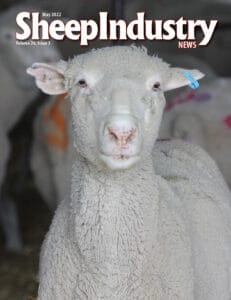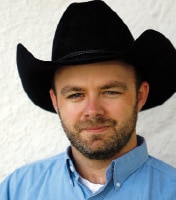TYLER COZZENS, PH.D.
Livestock Marketing Information Center
The Jan. 1 U.S. Department of Agriculture/National Agricultural Statistics Service Sheep and Goats report highlighted the continued downward trend for American wool production with 2021 at 22.451 million pounds – down 3 percent from the prior year. The lower wool production is due to a 2 percent decrease in sheep shorn to 3.2 million head, while the yield was down slightly from the prior year at 7 lbs. per head.
Let’s look at wool from a supply and utilization perspective. Supplies in 2021 started the year with beginning stocks of 21.2 million clean pounds which was the highest in five years. Production was 11.9 million clean pounds last year, down 3 percent with imports at 3.8 million clean pounds. This gave a total wool supply of 36.9 million clean pounds, up 12 percent from last year and the highest in three years.
On the utilization side of the balance sheet, wool mill use was estimated at 10 million clean pounds. Exports were 6.7 million clean pounds in 2021 – 2.3 million clean pounds above 2020. Total use for the year was 16.7 million clean pounds, which left ending stocks at 20.2 million clean pounds – the second highest level since 2016. Overall, wool production and use have been trending generally lower and will likely continue to do so given the decline in sheep numbers.
Focusing on state level wool production, eight states accounted for nearly two-thirds (64 percent) of total production in 2021 (Calif., Colo., Idaho, Mont., S.D., Texas, Utah and Wyo.). California and Colorado both produced nearly 2.2 million pounds last year, which was down 10 percent and 5 percent, respectively, from 2020. Wyoming and Utah posted declines of 9 percent and 6 percent, respectively, with production of 2.1 and 2.0 million pounds. California, Colorado, Wyoming and Utah – the only four states with wool production of more than 2 million pounds – accounted for 38 percent of total production in 2021.
Ten years ago, there were six states (Calif., Colo., Wyo., Utah, Idaho and Texas) that had wool production or more than 2 million pounds. Wool production in South Dakota rose 1 percent to more than 1.7 million pounds, the only top producing state to post an increase in production last year. Declines of 9 percent and 8 percent were seen in Montana and Idaho, respectively, to 1.5 and 1.4 million pounds. The remaining states all saw wool production figures below one million pounds and most recognized a decline from a year ago.
WOOL MARKET UPDATE
The Australian Eastern Market Indicator averaged just more than 1,400 per cents kg clean in March, down 2 percent from February’s 1,428 average, but an 8 percent increase over the prior year’s monthly average of 1,295. The first two weeks of April, the Australian EMI moved lower with the most recent week at 1,369 per cents kg clean, which is the lowest weekly price so far this year. Since the start of 2022, the EMI has averaged about U.S. $4.64 per lb. (Aus. $6.37 per lb.), this is higher than the same period last year which averaged about U.S. $4.48 per lb. (Aus. $5.79 per lb.).
In recent weeks, prices for the finer wools – between 17 and 21 microns – have generally been even to slightly higher than last March. Compared to a year ago, prices through the first quarter of the year have been above 2021 levels. Prices for the 17 to 19 micron wools are trending higher than last year. The 19 to 21 micron wools have been flat to slightly higher than a year ago. Prices for the 21 to 23 micron wools in early April were trending about even with prices in March.
Compared to a year ago, prices have seen smaller gains of about 2 to 3 percent. The market for 25 to 26 micron wools has moved lower in recent weeks with prices ranging from down 5 percent to as much as a 12 percent decline.
China continues its zero tolerance policy on COVID-19 cases, which has started to raise concern as to potential implications to wool demand. As of this writing, wool prices have generally remained level since the start of this year with recent prices tracking above a year ago, indicating demand repercussions so far have been limited. If China’s zero tolerance measures on COVID-19 persist, that could limit wool demand and pressure prices in the near term.
LAMB MARKET UPDATE
Lamb and yearling slaughter were on a slower pace through the first quarter of 2022, averaging about 30,000 head per week – 13 percent below the same period last year. The first quarter of 2022 saw lamb and yearling dressed weights track about 1 percent below a year ago at 67 pounds. The lower slaughter rate
and marginal decrease in dressed weights combined to a nearly 13 percent decline in lamb production for the first quarter of 2022.
Weekly slaughter typically rises leading up to Easter as retail stores feature more lamb. This year, Easter fell later – on April 17 – and as of this writing weekly slaughter had started to increase. The last two weeks of March saw weekly lamb and yearling slaughter jump nearly 10 to 15 percent week-over-week to more than 36,000 and nearly 40,000 head, respectively. Elevated levels were expected to occur in weekly slaughter for the week leading up to Easter. Last year, weekly lamb and yearling slaughter was about or just less than 40,000 head in the three weeks leading up to Easter, indicating that this year’s slaughter levels are tracking lower than those of 2021. The lower slaughter levels are supporting lamb prices.
This Easter, consumers were facing much higher lamb prices than they did last year. Since the start of the year, the lamb cutout value has maintained an elevated level averaging around $6 per pound. The first full week of April saw the lamb cutout value slump slightly to $5.89 per pound, which is the lowest price since late-July last year. Compared to the same week a year ago, the lamb cutout value was 39 percent – or $1.66 per pound – higher. Similar jumps in prices have also occurred in most lamb cuts. This year, the shoulder has averaged more than $4.77 per pound through the first quarter – a 31 percent increase from last year.
The first quarter average price of legs was more than $5.90 per pound – up 31 percent from 2021. The average loin price has increased 36 percent from a year ago to $9.37 per pound. The rack has been the most impressive lamb cut as it has seen the largest increase, rising 58 percent during the first quarter to more than $15 per pound.
The smaller than expected pace to lamb and yearling slaughter through the first quarter of this year has led to the Livestock Marketing Information Center revising its 2022 slaughter forecast to 2.135 million head – down 5 percent from last year. Weights are expected to trend approximately 1 percent below 2021, leading to a more than 6 percent decline in lamb production to 129.1 million pounds for the year. The lower production is expected to keep slaughter lamb prices (national negotiated live) above a year ago by about 5 percent with a range of $221 to $236 per cwt. this year. Feeder lamb prices (three-market average, Colo., S.D. and Texas) for the year are forecast at $293 to $305 per cwt, up 10 percent from last year.
Recent data from the Bureau of Labor Statistics on the Consumer Price Index showed inflation jumped 8.5 percent in March. This is the highest inflation rate since December of 1981, which was 8.9 percent. Inflationary pressures are likely to be a headwind to the larger macro economy, but the demand for meat looks optimistic.
For lamb demand, the lamb cutout value averaging more than $6 per pound since late-July last year is an indication that demand remains robust.
Further, the American Lamb Board study conducted in October 2021 showed that heavy lamb purchasers tend to be college-educated millennials with families making more than $100,000 a year and live in urban areas.
This would suggest that heavy lamb users have a higher degree of disposable income, allowing them some flexibility to absorb the elevated lamb prices.




